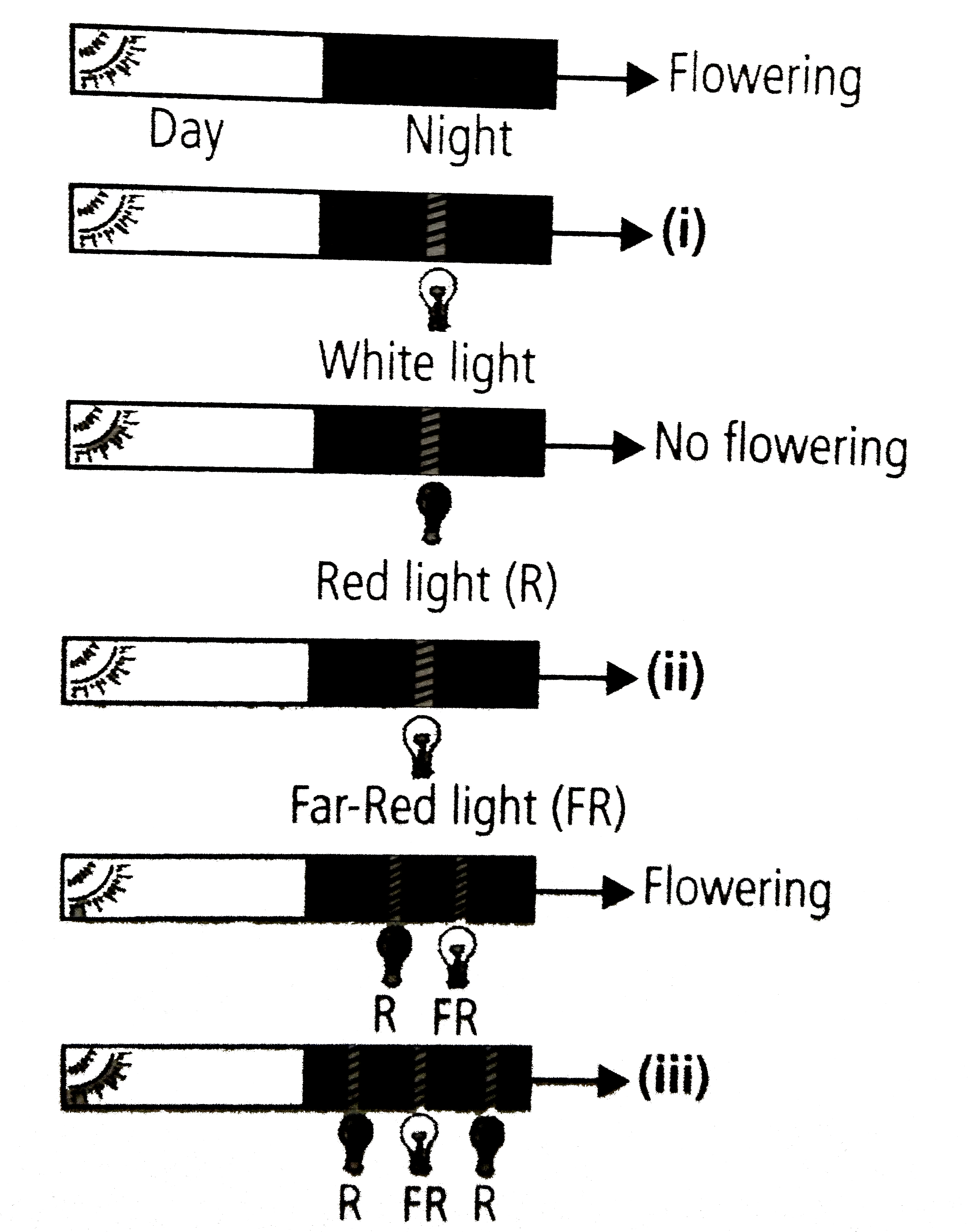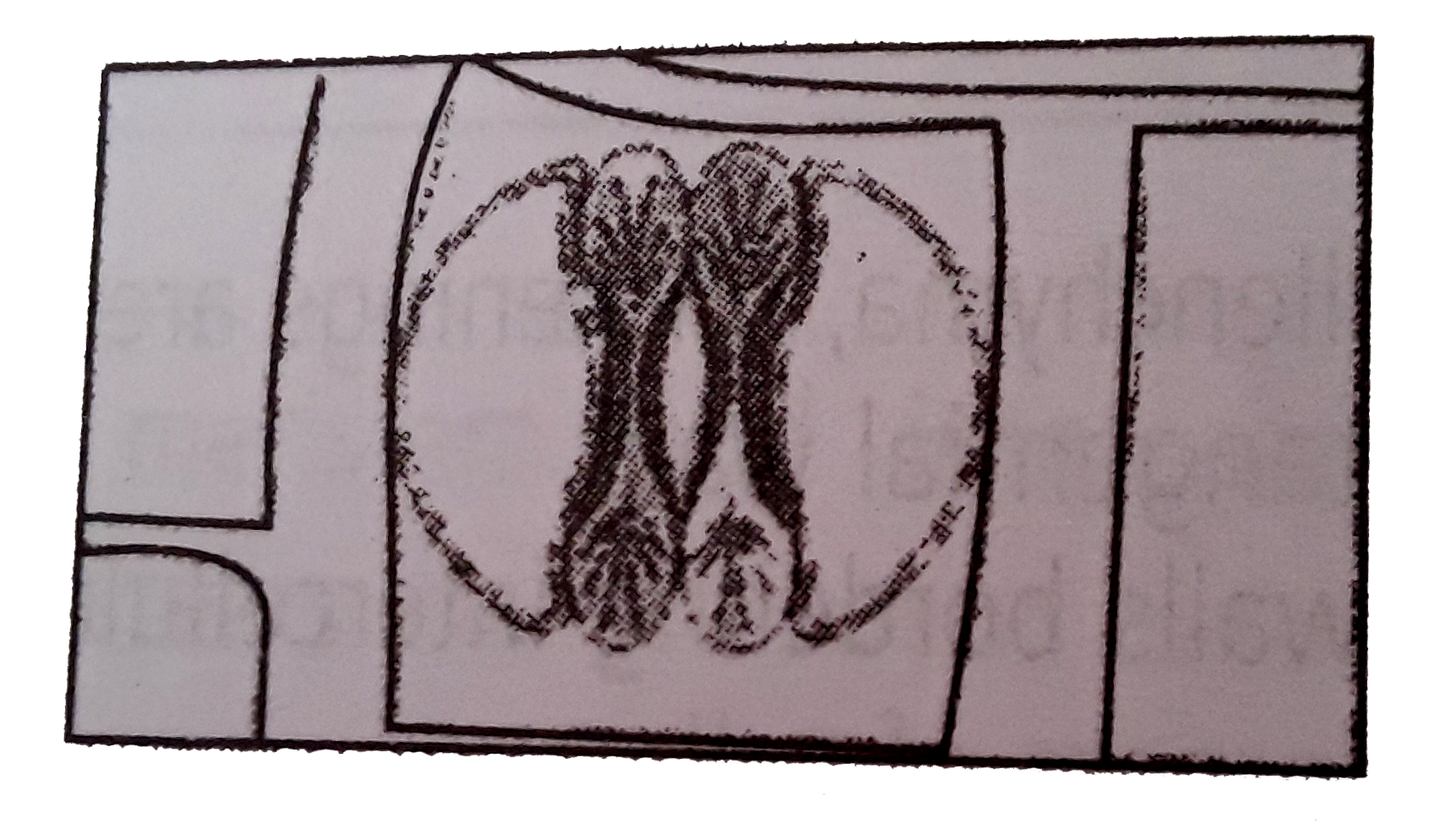Four potted plants (I,II, III, and IV) of a short day plant, which has the crictical period of 14 hours, are taken and exposed to light for different time periods. The light periods given are listed in the table.
∣∣
∣
∣
∣
∣
∣∣Potted plantPhotoperiodI10hrsII15hrsIII16hrsIV20hrs∣∣
∣
∣
∣
∣
∣∣
Which potted plant will show flowering after exposure to light?
I
II
III
IV
The correct Answer is:A
To determine which potted plant will show flowering after exposure to light, we need to analyze the light exposure of each plant in relation to the critical photoperiod for a short day plant, which is 14 hours.
1. Identify the Critical Photoperiod:
- The critical photoperiod for the short day plant is 14 hours. This means that the plant will flower only when it receives light for less than 14 hours.
2. Review the Light Exposure of Each Plant:
- Plant I: 10 hours
- Plant II: 15 hours
- Plant III: 16 hours
- Plant IV: 20 hours
3. Compare Each Plant's Light Exposure to the Critical Period:
- Plant I (10 hours): This is less than 14 hours, so it is suitable for flowering.
- Plant II (15 hours): This is more than 14 hours, so it will not flower.
- Plant III (16 hours): This is also more than 14 hours, so it will not flower.
- Plant IV (20 hours): This is significantly more than 14 hours, so it will not flower.
4. Conclusion:
- Only Plant I, which has been exposed to light for 10 hours, meets the criteria for flowering since it is below the critical period of 14 hours. Therefore, Plant I will show flowering after exposure to light.
Final Answer:
- The potted plant that will show flowering after exposure to light is Plant I.
- The critical photoperiod for the short day plant is 14 hours. This means that the plant will flower only when it receives light for less than 14 hours.
- Plant I: 10 hours
- Plant II: 15 hours
- Plant III: 16 hours
- Plant IV: 20 hours
- Plant I (10 hours): This is less than 14 hours, so it is suitable for flowering.
- Plant II (15 hours): This is more than 14 hours, so it will not flower.
- Plant III (16 hours): This is also more than 14 hours, so it will not flower.
- Plant IV (20 hours): This is significantly more than 14 hours, so it will not flower.
- Only Plant I, which has been exposed to light for 10 hours, meets the criteria for flowering since it is below the critical period of 14 hours. Therefore, Plant I will show flowering after exposure to light.
- The potted plant that will show flowering after exposure to light is Plant I.
Topper's Solved these Questions
- PLANT GROWTH AND DEVELOPMENTBOOK - NCERT FINGERTPS ENGLISHCHAPTER - PLANT GROWTH AND DEVELOPMENTEXERCISE - Vernalisation
4 Videos
- PLANT GROWTH AND DEVELOPMENTBOOK - NCERT FINGERTPS ENGLISHCHAPTER - PLANT GROWTH AND DEVELOPMENTEXERCISE - Seed dormancy
5 Videos
- PLANT GROWTH AND DEVELOPMENTBOOK - NCERT FINGERTPS ENGLISHCHAPTER - PLANT GROWTH AND DEVELOPMENTEXERCISE - Plant growth regulators
70 Videos
- PHOTOSYNTHESIS IN HIGHER PLANTSBOOK - NCERT FINGERTPS ENGLISHCHAPTER - PHOTOSYNTHESIS IN HIGHER PLANTSEXERCISE - Photosynthesis In Higher Plants
136 Videos
- PLANT KINGDOMBOOK - NCERT FINGERTPS ENGLISHCHAPTER - PLANT KINGDOMEXERCISE - Plant Kingdom
160 Videos
Similar Questions
There are two plants A and B with respective critical photoperiod of 13 hours and 11 hours.When they are exposed to light for a period of 12 hour, it initiated flowering in both. Which of the following conclusions is most appropriate for these plants ?
View SolutionOne set of a plant was grown at 12 hours day and 12 hours night period cycle and it flowered while in the other set night period cycles and it flowered while in the other set night phase was interrupted by flash of light and did not produce flower. Under which one of the following categories will you place this plant
View Solution
Knowledge Check
Cabbage is a biennial plant which produces flowers in second year of growth. In an attempt to make it flower in a single year, four potted plants (I,II, II, and IV) of cabbage were subjected to different temperatures for several days as given in the table.
∣∣ ∣ ∣ ∣ ∣ ∣∣Potted plantTemperatureI5∘CII20∘CIII30∘CIV25∘C∣∣ ∣ ∣ ∣ ∣ ∣∣
Which potted plant will show flowering ?AIBIICIIIDIVGiven figure shows the effect of interruption of skotoperiod (dark period) in a short day plant by light of different types.

Select the correct option for (i),(ii) and (iii).A(i)(ii)(iii)FloweringFloweringNo floweringB(i)(ii)(iii)No floweringNo flowering FloweringC(i)(ii)(iii)No floweringFloweringNo floweringD(i)(ii)(iii)FloweringNo floweringNo flowering
Identify the plants (from the list i-vi) which possess the given type of guars cells (as shown in the diagram) in their leaves.
(i). Grass
(ii). Tomato
(iii). Banana
(iv). Brinjal
(v). Soyabean
(vi) LilyA(i),(ii) and (v)B(ii), (iii) and (iv)C(i),(iii) and (vi)D(iv),(v) and (vi)
The half− life periods of four isotopes are give below :
(i)7.6years , ii.4000years
iii.6000years,iv.3.2×105years
Which of the above isotope is most stable ?
View SolutionSelect the correct statement related to flowering in plants.
I. Some plants require a periodic exposure to light to induce
flowering
II. The flowering is either quantitatively or qualitatively dependent
on exposure to low temperature.
III. The site of perception of light/dark duration is the stem apex.
IV. Flowering in plants is due to the hormones produced in the
shoot apex.
View SolutionWhich of the following statements are true for flowers?
(i) Flowers are always bisexual
(ii) They are the sexual reproductive organs
(iii) They are produced in all groups of plants
(iv) After fertilisation they give rise to fruits
View Solution(a) How is the valency of an element determined if its electronic configuration is known? Determine the valency of an element of atomic no. 9
(b) Given below are some elements of the Modern Periodic Table. Atomic numbers of the elements are given in the parentheses:
A(4), B(9), C(14), D(19), E(20)
(i) With the help of the electronic configuration, find out which one of the above elements will have one electron in its outermost shell?
(ii) Which rwo elements belong to the same group? Give reasons for your answer.
(iii) Which one of the above elements belonging to the fourth period has bigger atomic radius and why?.
View SolutionStudy following statements regarding the preparation of herbarium sheets.
(i) Plant should be collected in flowering stage.
(ii) Every detail regarding the plant such sa locality, ecological conditions, vegetative and floral characters, etc. should be noted.
(iii) Plants are evenly pressed by unfolding all the plant parts between blotting papers (or newspapers) with the help of plant pressers.
(iv) Blotting papers need not be changed until the plant gets dried.
(v) After drying, the plant specimen is carefully mounted/pasted on the herbarium sheets.
(vi) The herbarium sheet is labelled on the lower right hand corner representing the number of plant specimen, data of collection, etc.
Which of the above statements is/are correct ?
View Solution
